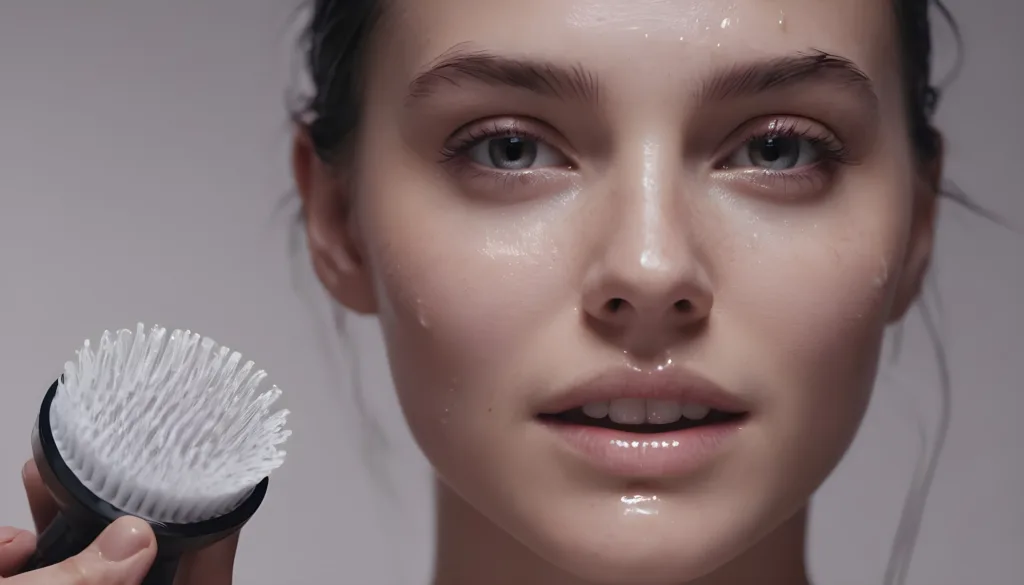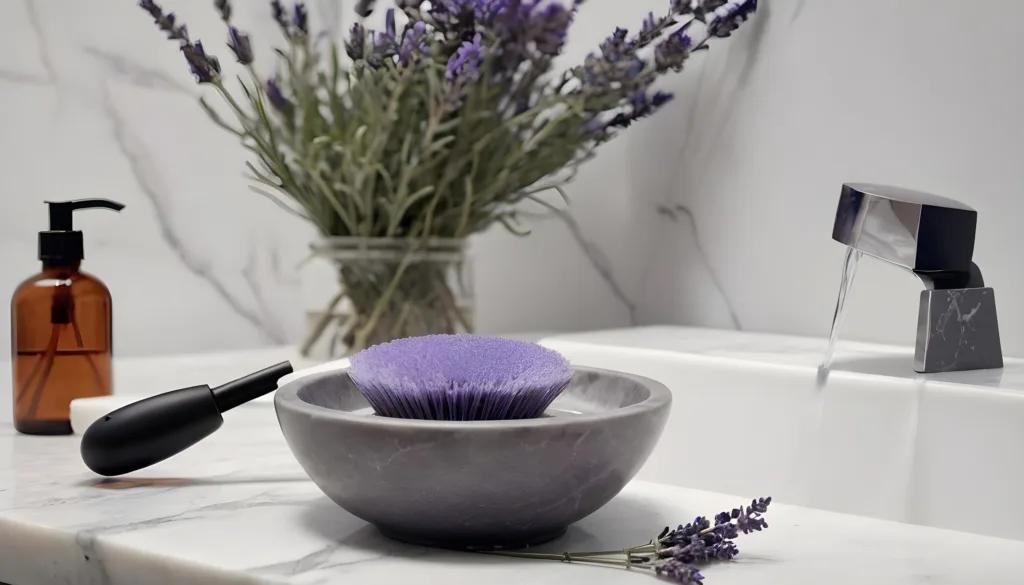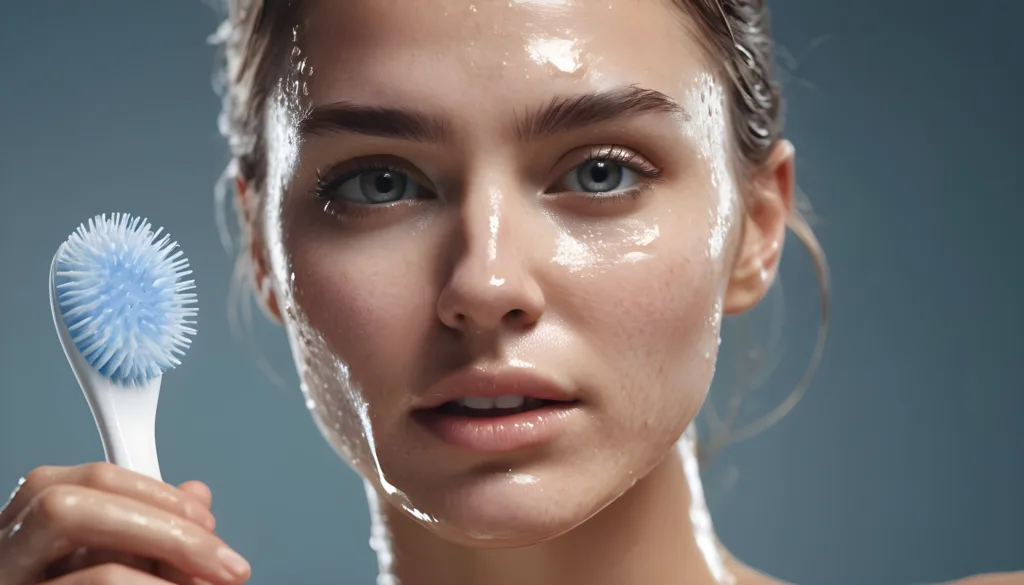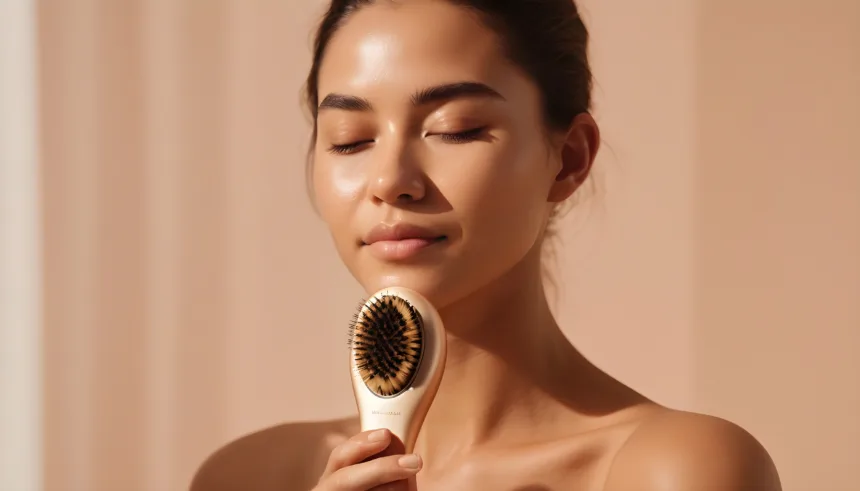There are two types of people in the skincare world; some who prefer washing their faces with their hands, while others that put their trust in cleansing brushes! Have you ever heard of them? They’re these neat little gadgets that are all the rage in skincare.
I used to be in the hand-washing camp but one day I stumbled upon them while browsing the aisles at a store and decided to give it a shot. And I’ve been hooked since then.
Table of Contents
Understanding the Buzz: What Exactly is a Cleansing Brush?
So you’re washing your face, trying to get rid of all the dirt and oil that builds up during the day. You use your hands, but sometimes it feels like they’re not doing enough. That’s where the cleansing brush comes in!
It is like a tiny electric toothbrush for your face. It has soft bristles that rotate or vibrate to help clean your skin more deeply than just using your hands alone. It’s kind of like getting a mini spa treatment right in your own bathroom!
Joining the Trend: Why Cleansing Brushes Are Everywhere
These brushes have become really popular because they promise to give you cleaner, smoother skin. People are talking about them everywhere – from beauty blogs to social media. It’s like they’ve become the latest must-have accessory for anyone serious about taking care of their skin.
Now that you know a bit about what a cleansing brush is, let’s dive deeper into how they actually work and whether they’re worth all the hype!
The Science Behind Cleansing Brushes: Fact or Fiction?

First off, let’s bust some myths. You might have heard people saying that this tool is too harsh for your skin or that they can cause more harm than good. Well, guess what? That’s not entirely true!
Debunking Myths: Separating Truth from Marketing Hype
- They are too harsh for the skin:
- Debunked: While it’s true that some brushes can be harsh if used incorrectly, many modern brushes offer adjustable settings and softer brush heads specifically designed for gentle cleansing. By using the appropriate settings and techniques, cleansing brushes can effectively remove impurities without causing harm to the skin.
- They are only for acne-prone skin:
- Debunked: Cleansing brushes can benefit various skin types, not just acne-prone skin. They help remove dirt, oil, and dead skin cells, leading to a clearer and healthier complexion for all skin types. Whether you have normal, oily, dry, or combination skin, this tool can be a valuable addition to your skincare routine.
- They are unnecessary if you use your hands:
- Debunked: While washing your face with your hands is better than not cleansing at all, cleansing brushes offer additional benefits. Their rotating or vibrating bristles provide a deeper cleanse, reaching into pores to remove impurities that hands alone may miss. This leads to a more thorough and effective cleansing experience.
- They can cause broken capillaries:
- Debunked: Broken capillaries are more likely to occur due to factors like genetics, sun exposure, or aggressive skincare techniques rather than the use of cleansing brushes. When used properly and with gentle pressure, they are unlikely to cause broken capillaries. Opting for brushes with softer bristles and avoiding excessive pressure can further minimize this risk.
- They are too expensive:
- Debunked: While some brushes may come with a higher price tag, there are plenty of affordable options available on the market. Additionally, considering the potential benefits to your skin, such as improved cleansing, exfoliation, and overall skin health, many people find that investing in a quality cleansing brush is worthwhile. Moreover, these brushes are often durable and can last a long time, providing long-term value for your skincare routine.
Pro Tip: Choose a brush with soft bristles and adjustable speeds to avoid irritation, especially if you have sensitive skin.
How They Work Their Magic?
So, how do these brushes actually do their thing? It’s all about the power of vibration or rotation! When you turn it on, it creates gentle movements that help loosen up dirt, oil, and dead skin cells from your pores.
The bristles of the cleansing brush work together with your favorite cleanser to create a rich lather, ensuring a deeper clean than just using your hands alone. This helps to unclog pores, prevent breakouts, and leave your skin feeling fresh and rejuvenated.
For deeper insights, check out my article on clogged pores where I delve into the nitty-gritty of congested skin.
Pro Tip: Use a gentle, circular motion when using it to ensure thorough but gentle cleansing. Avoid pressing too hard or using it for too long, as this can cause irritation.
Pros and Cons of Incorporating a Cleansing Brush Into Your Skincare Routine

All set to buy your first cleansing brush? Hold your horses! before you swipe that card, let’s take a closer look at what it brings to the table and where it might trip you up.
The Benefits of Using a Cleansing Brush :Is It Worth the Hype?
Deep Cleansing: Think of a cleansing brush as your skin’s personal Minion. It dives deep into your pores, sweeping away all the dirt, oil, and impurities that can build up throughout the day and gives your skin a fresh start!
Buffing Away Dead Skin Cells: You know that feeling when you scrub away dead skin cells and reveal the smooth, radiant skin underneath? That’s what a cleansing brush does! It gently exfoliates your skin, leaving it feeling soft and rejuvenated.
Improved Circulation: Ever notice how your face feels tingly and refreshed after using a cleansing brush? That’s because it helps improve circulation, bringing oxygen and nutrients to your skin cells for a healthy, glowing complexion.
Reduces Blackheads and Breakouts: By thoroughly cleansing the skin and unclogging pores, cleansing brushes can help reduce the formation of blackheads and stop those pesky breakouts. They effectively remove oil, dirt, and dead skin cells, keeping clogged pores and blemishes at bay.
Promotes Product Absorption: Using a cleansing brush before applying skincare products can help enhance their absorption into the skin. By removing impurities and exfoliating the skin’s surface, they help create a clean base for skincare products to absorb more effectively, maximizing their benefits.
Pro Tip: Start with a lower speed setting and gradually increase the intensity as your skin gets used to the brush. This can help prevent irritation and ensure a comfortable cleansing experience.
The Caveats: Potential Drawbacks and Precautions
Irritation: Now, let’s talk about the not-so-fun stuff. Some people might experience irritation when using a cleansing brush, especially if they have sensitive skin. It’s important to listen to your skin and adjust your routine accordingly. If you notice any redness or discomfort, take a break from using the brush or switch to a softer brush head.
Is It a Worthy Investment: Cleansing brushes can range in price from affordable to splurge-worthy. While some may see it as an investment in their skincare routine, others might find it a bit pricey. It’s essential to weigh the cost against the potential benefits and decide what works best for your budget.
Overuse: Using a cleansing brush too frequently or with too much pressure can over-exfoliate and irritate the skin. It’s important to follow the manufacturer’s recommendations for frequency and pressure and to listen to your skin’s needs. If your skin starts to feel sensitive or irritated, stop using it immediately or take a break.
Hygiene Concerns: If not cleaned properly, cleansing brushes can harbor bacteria and other germs, which can lead to breakouts and skin infections. It’s essential to clean your brush regularly and replace the brush head as recommended by the manufacturer to maintain optimal hygiene and prevent potential skin issues.
Skin Sensitivity: While many people can benefit from using a cleansing brush, those with extremely sensitive skin may find that the bristles are too abrasive and irritating. It’s important to consider your skin type and any specific sensitivities when choosing this brush and to start with a softer brush head and lower speed setting always!
Pro Tip: Look for cleansing brushes that come with interchangeable brush heads or are rechargeable. This can help save money in the long run by extending the life of your brush and providing versatility in your skincare routine.
Tailoring to Different Skin Types: How Cleansing Brushes Work for Everyone

So you’re at a store, surrounded by a plethora of cleansing brush options . How do you know which one is right for you? Well, it all depends on your skin type. Let me break it down for you!
Normal Skin: Maintaining Balance and Radiance
So, you’re one of the lucky ones with normal skin. You don’t have to worry too much about breakouts or dry patches. For you, a gentle cleansing brush with soft bristles will do the trick. It’ll help keep your skin clean and fresh without causing any trouble.
Pro Tip: Use once or twice a week to maintain your skin’s natural balance. Over-cleansing can strip away your skin’s natural oils, so be gentle!
Oily/Acne-Prone Skin: Controlling Sebum and Fighting Breakouts
If you’re constantly battling oily skin and pesky breakouts, a cleansing brush can be your secret weapon. Look for a brush with gentle yet effective cleansing action to help remove excess oil and unclog pores. Go for brushes with antimicrobial bristles to keep bacteria at bay.
Pro Tip: Cleanse your face twice a day with your cleansing brush to keep oiliness and breakouts in check. Don’t forget to cleanse gently and avoid scrubbing too hard, as this can irritate your skin and worsen breakouts.
Dry/Sensitive Skin: Gentle Cleansing Without Stripping Moisture
Dry, sensitive skin requires extra TLC, and a cleansing brush can still be part of your skincare routine with the right approach. Go for ultra-soft bristles and adjustable settings to suit your skin’s needs. Look for brushes with hydrating features to help soothe and moisturize your skin while cleansing.
For in-depth insights, check out our 10 experts tips for dry skin in winter.
Pro Tip: Use your cleansing brush only once a week to avoid over-stimulating your skin. Follow up with a gentle, hydrating natural moisturizer to lock in moisture and keep your skin feeling soft and supple.
For more information on natural moisturizers, check out this guide.
Combination Skin: The Brush Struggle is Real (But So Are Solutions!
Ah, the tricky combination skin! If you’ve got oily patches in some areas and dryness in others, a cleansing brush can help balance things out. Look for a brush with customizable settings so you can adjust the intensity based on different areas of your face. Focus on gentle exfoliation to unclog pores without stripping away moisture.
Pro Tip: The best time to use is in the evening to remove makeup, dirt, and oil accumulated throughout the day. Follow up with a lightweight, oil-free non comedogenic moisturizer to keep your skin hydrated without adding excess oil.
If you’re interested in learning more about non comedogenic moisturisers, I’ve covered it extensively in my article here.
Tips for Maximizing the Effectiveness of Your Cleansing Brush

I had no idea which cleansing brush to choose or how to use it properly when I first got my hands on it. But after a bit of trial and error, I figured out some tips that made all the difference. Let me share them with you!
Choosing the Right Brush
There’s a bunch of options available at the market, and I know it can be a bit overwhelming to find your perfect match. But don’t fret! It all depends on your skin type and your needs. Avoid the manual ones if you’re just starting off and look for a brush with soft bristles and adjustable settings, so you can customize your cleansing experience.
Pro Tip: Do a little research before you buy and read reviews from other people with similar skin concerns. This can help you find the perfect brush for you!
Establishing a Safe Cleansing Routine
Now that you’ve got your cleansing brush, it’s time to establish a safe and effective cleansing routine. Start by wetting your face and applying your favorite cleanser. Then, gently glide the brush over your skin in circular motions, focusing on areas that need extra attention.
Frequency Matters: How Often Should You Use Your Cleansing Brush?
Ah, the age-old question – how often should you use it? Well, as discussed in the previous section, it depends on your skin type and how it reacts to the brush. Having said that, you might want to take things slow no matter the skin type. Start by using it once or twice a week and see how your skin responds.
Pro Tip: Pay attention to how your skin feels after using the brush. If it starts to feel dry or irritated, you might be using it too often. Listen to your skin and adjust your routine accordingly.
Precautions and Best Practices for Optimal Results
Last but not least, let’s talk about some precautions to keep in mind when using your cleansing brush. Avoid using the brush on broken or irritated skin, as this can cause further irritation. And always make sure to clean your brush regularly to prevent bacteria build-up.
Pro Tip: Clean your brush after each use by rinsing it thoroughly with water and allowing it to air dry. You can also use a gentle cleanser or brush cleaner to remove any residue.
Final Thoughts
Alright, you’ve learned all about how cleansing brushes work, how to choose the right one for your skin type, and how to use it safely and effectively. But now what?
Well, here’s the thing – skincare isn’t just about using the fanciest products or following the latest trends. It’s about taking care of your skin in a way that makes you feel good. Whether you’re using a cleansing brush or sticking to a simple routine with just a cleanser and moisturizer, what matters most is that you’re taking the time to listen to your skin and give it the love and attention it deserves.
So, always remember to keep experimenting, keep learning, and most importantly, keep loving the skin you’re in. After all, it’s the only skin you’ve got!
Ready to experience smoother, clearer skin effortlessly? Why not give the cleansing brush a try today?
FAQs
1. Are cleansing brushes suitable for all skin types?
- Yes, they can be suitable for various skin types, including normal, oily, dry, sensitive, and combination skin. However, it’s essential to choose a brush with features and settings tailored to your specific skin needs.
2. How often should I use a cleansing brush?
- The usage frequency depends on your skin type and its reaction to the brush. For sensitive skin, starting with once or twice a week and gradually increasing the frequency may be suitable. Others may use it daily or every other day. Listen to your skin and adjust your routine accordingly.
3. Can cleansing brushes cause skin irritation?
- While they can provide effective cleansing, they may cause irritation, especially if used too frequently or with too much pressure. It’s crucial to start with a gentle approach, use appropriate settings, and pay attention to how your skin reacts. If irritation occurs, reduce the frequency or intensity of use.
4. How do I clean and maintain my cleansing brush?
- Cleaning it regularly is essential to prevent bacteria build-up and maintain optimal hygiene. Rinse the brush head thoroughly after each use and allow it to air dry. Additionally, consider using a gentle cleanser or brush cleaner to remove any residue. Replace the brush head as recommended by the manufacturer.
5. Can I use a cleansing brush with other skincare products?
- Yes, you can use it with other skincare products, such as cleansers, exfoliants, and serums. Using a cleansing brush before applying skincare products can help enhance their absorption into the skin by removing impurities and exfoliating the skin’s surface. However, it’s essential to follow up with moisturizers and other products to keep your skin hydrated and balanced.



Leave a Reply